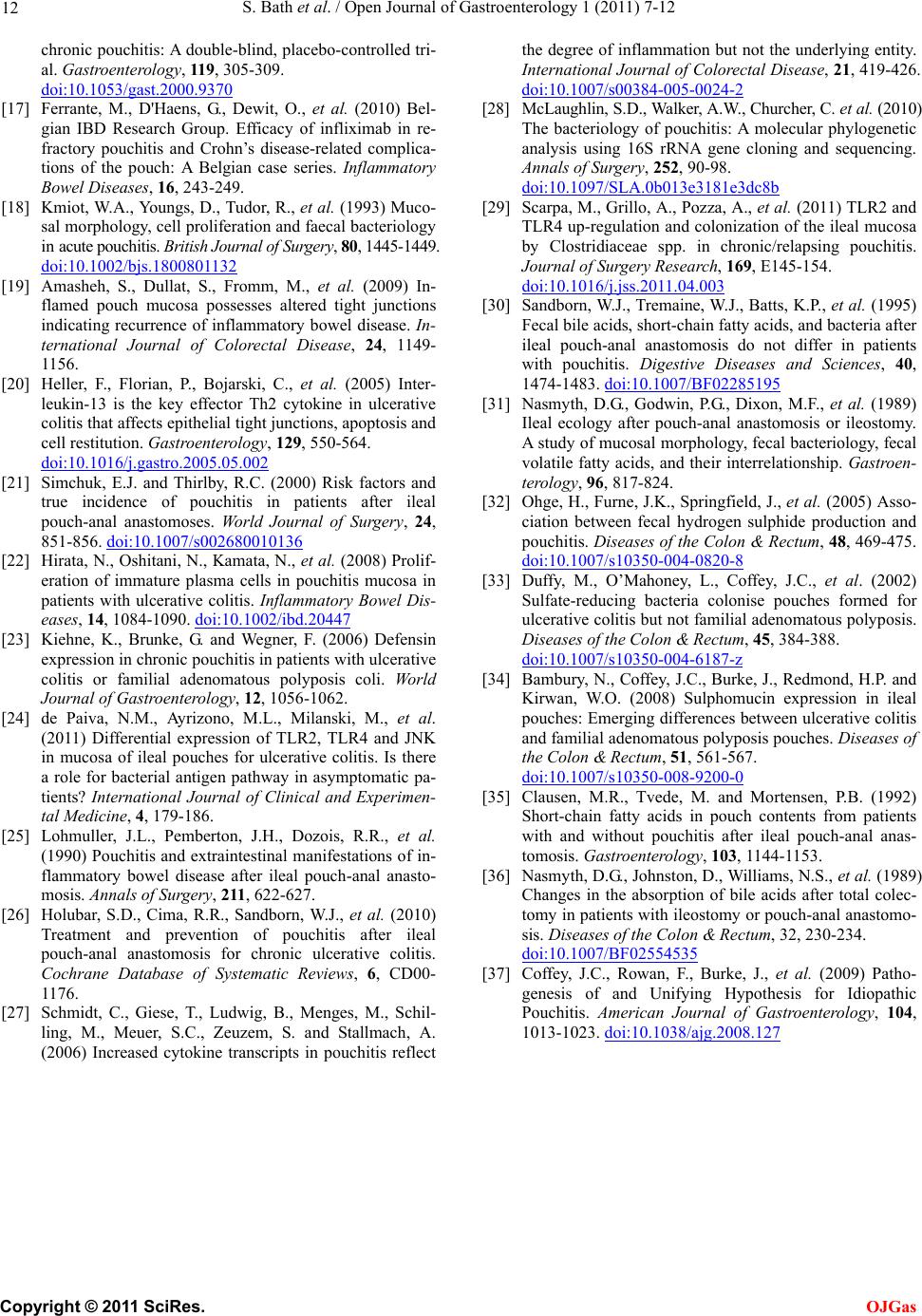
S. Bath et al. / Open Journal of Gastroenterology 1 (2011) 7-12
Copyright © 2011 SciRes.
12
OJGas
chronic pouchitis: A double-blind, placebo-controlled tri-
al. G astroenterology, 119, 305-309.
doi:10.1053/gast.2000.9370
[17] Ferrante, M., D'Haens, G., Dewit, O., et al. (2010) Bel-
gian IBD Research Group. Efficacy of infliximab in re-
fractory pouchitis and Crohn’s disease-related complica-
tions of the pouch: A Belgian case series. Inflammatory
Bowel Diseases, 16, 243-249.
[18] Kmiot, W.A., Youngs, D., Tudor, R., et al. (1993) Muco-
sal morphology, cell proliferation and faecal bacteriology
in acute pouchitis. Br itish Journa l of Sur ger y, 80, 1445-1449 .
doi:10.1002/bjs.1800801132
[19] Amasheh, S., Dullat, S., Fromm, M., et al. (2009) In-
flamed pouch mucosa possesses altered tight junctions
indicating recurrence of inflammatory bowel disease. In-
ternational Journal of Colorectal Disease, 24, 1149-
1156.
[20] Heller, F., Florian, P., Bojarski, C., et al. (2005) Inter-
leukin-13 is the key effector Th2 cytokine in ulcerative
colitis that affects epithelial tight junctions, apoptosis and
cell restitution. Gastroenterology, 129, 550-564.
doi:10.1016/j.gastro.2005.05.002
[21] Simchuk, E.J. and Thirlby, R.C. (2000) Risk factors and
true incidence of pouchitis in patients after ileal
pouch-anal anastomoses. World Journal of Surgery, 24,
851-856. doi:10.1007/s002680010136
[22] Hirata, N., Oshitani, N., Kamata, N., et al . (2008) Prolif-
eration of immature plasma cells in pouchitis mucosa in
patients with ulcerative colitis. Inflammatory Bowel Dis-
eases, 14, 1084-1090. doi:10.1002/ibd.20447
[23] Kiehne, K., Brunke, G. and Wegner, F. (2006) Defensin
expression in chronic pouchitis in patients with ulcerative
colitis or familial adenomatous polyposis coli. World
Journal of Gastroenterology, 12, 1056-1062.
[24] de Paiva, N.M., Ayrizono, M.L., Milanski, M., et al.
(2011) Differential expression of TLR2, TLR4 and JNK
in mucosa of ileal pouches for ulcerative colitis. Is there
a role for bacterial antigen pathway in asymptomatic pa-
tients? International Journal of Clinical and Experimen-
tal Medicine, 4, 179-186.
[25] Lohmuller, J.L., Pemberton, J.H., Dozois, R.R., et al.
(1990) Pouchitis and extraintestinal manifestations of in-
flammatory bowel disease after ileal pouch-anal anasto-
mosis. Annals of Surgery, 211, 622-627.
[26] Holubar, S.D., Cima, R.R., Sandborn, W.J., et al. (2010)
Treatment and prevention of pouchitis after ileal
pouch-anal anastomosis for chronic ulcerative colitis.
Cochrane Database of Systematic Reviews, 6, CD00-
1176.
[27] Schmidt, C., Giese, T., Ludwig, B., Menges, M., Schil-
ling, M., Meuer, S.C., Zeuzem, S. and Stallmach, A.
(2006) Increased cytokine transcripts in pouchitis reflect
the degree of inflammation but not the underlying entity.
International Journal of Colorectal Disease, 21, 419-426.
doi:10.1007/s00384-005-0024-2
[28] McLaughlin, S.D., Walker, A.W., Churcher, C. et al. (2010)
The bacteriology of pouchitis: A molecular phylogenetic
analysis using 16S rRNA gene cloning and sequencing.
Annals of Surgery, 252, 90-98.
doi:10.1097/SLA.0b013e3181e3dc8b
[29] Scarpa, M., Grillo, A., Pozza, A., et al. (2011) TLR2 and
TLR4 up-regulation and colonization of the ileal mucosa
by Clostridiaceae spp. in chronic/relapsing pouchitis.
Journal of Surgery Research, 169, E145-154.
doi:10.1016/j.jss.2011.04.003
[30] Sandborn, W.J., Tremaine, W.J., Batts, K.P., et al. (1995)
Fecal bile acids, short-chain fatty acids, and bacteria after
ileal pouch-anal anastomosis do not differ in patients
with pouchitis. Digestive Diseases and Sciences, 40,
1474-1483. doi:10.1007/BF02285195
[31] Nasmyth, D.G., Godwin, P.G., Dixon, M.F., et al. (1989)
Ileal ecology after pouch-anal anastomosis or ileostomy.
A study of mucosal morphology, fecal bacteriology, fecal
volatile fatty acids, and their interrelationship. Gastroen-
terology, 96, 817-824.
[32] Ohge, H., Furne, J.K., Springfield, J., et al. (2005) Asso-
ciation between fecal hydrogen sulphide production and
pouchitis. Diseases of the Colon & Rectum, 48, 469-475.
doi:10.1007/s10350-004-0820-8
[33] Duffy, M., O’Mahoney, L., Coffey, J.C., et al. (2002)
Sulfate-reducing bacteria colonise pouches formed for
ulcerative colitis but not familial adenomatous polyposis.
Diseases of the Colon & Rectum, 45, 384-388.
doi:10.1007/s10350-004-6187-z
[34] Bambury, N., Coffey, J.C., Burke, J., Redmond, H.P. and
Kirwan, W.O. (2008) Sulphomucin expression in ileal
pouches: Emerging differences between ulcerative colitis
and familial adenomatous polyposis pouches. Diseases of
the Colon & Rectum, 51, 561-567.
doi:10.1007/s10350-008-9200-0
[35] Clausen, M.R., Tvede, M. and Mortensen, P.B. (1992)
Short-chain fatty acids in pouch contents from patients
with and without pouchitis after ileal pouch-anal anas-
tomosis. Gastroenterology, 103, 1144-1153.
[36] Nasmyth, D.G., Johnston, D., Williams, N.S., et al. (1989)
Changes in the absorption of bile acids after total colec-
tomy in patients with ileostomy or pouch-anal anastomo-
sis. Diseases of the Colon & Rectum, 32, 230-234.
doi:10.1007/BF02554535
[37] Coffey, J.C., Rowan, F., Burke, J., et al. (2009) Patho-
genesis of and Unifying Hypothesis for Idiopathic
Pouchitis. American Journal of Gastroenterology, 104,
1013-1023. doi:10.1038/ajg.2008.127